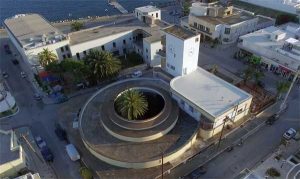The Architectural style of Leros
Leros architecture its a blend of 4 deferent styles, the typical style of Dodecanese, which has a lot of similarities with the architectural style of the Cyclades islands, small white houses with blue painted doors and windows.
The neoclassic style with the dominant colour of okra and finally the remaining Italian buildings from the times of the Italian occupation which most are in Laki and mostly good remain as a living museum of Mussolini’s architecture.
The last decade the modern Lerians build there houses with respect to the traditional local style.






The Italian architecture of Lakki

But let’s take things from the beginning. In 1912, the Dodecanese came under the control of the Italians who chose Leros for the creation of their aeronautical base. Lakki Bay, the second largest natural harbor in the Mediterranean after Malta, is ideal.

In Lakki, therefore, from 1930 to 1936, where there was a small fishing village, a new town, Porto Lago, was built from scratch. A city that had everything: from public buildings to residences for officers and soldiers. The result was a single architectural ensemble built on the principles of rationalism. “The church, the theater, the school, the hospital, the artillery barracks, the hotel and, above all, the circular market with the clock tower constitute a uniquely coherent architectural ensemble, which could deservedly be included in an international exhibition of architecture of the 1930s”.

